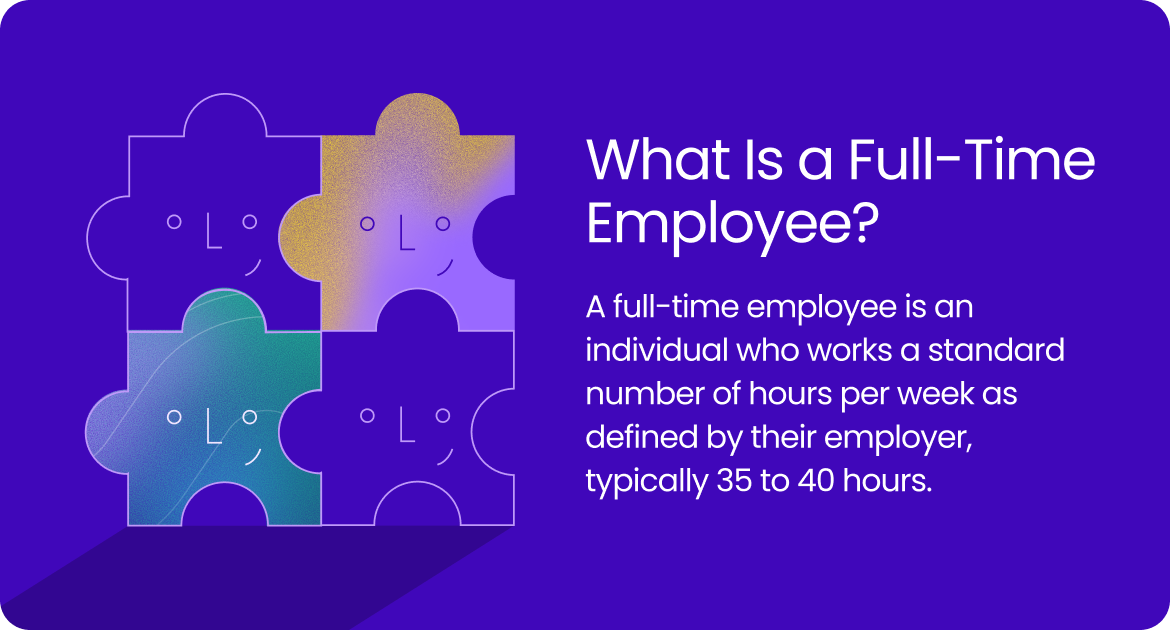As a business owner or human resources manager, you may come across the term "full-time employee," which generally refers to an individual employed to work a standard number of hours per week as defined by the employer, typically ranging from 35 to 40 hours. Understanding the classification of full-time employees is important because it affects eligibility for benefits, compliance with labor laws, and workforce planning.
For example, if your company defines full-time employment as 40 hours per week, employees meeting this criterion may be entitled to benefits such as health insurance, paid time off, and retirement plans. Properly classifying employees ensures compliance with regulations and helps maintain a satisfied and productive workforce.

What Are the Standard Hours for Full-Time Employees?
The standard for full-time hours refers to the number of hours an employee is expected to work per week to be classified as a full-time employee. This threshold varies by country, industry, and employer, typically ranging from 30 to 40 hours per week. Understanding these standards is essential for HR professionals, employers, and employees to ensure compliance with labor laws, determine benefit eligibility, and clarify employment expectations.
General
Full-time hours are the minimum hours an employee must work to be considered full-time, as opposed to part-time or casual employment. While there is no universal global standard, full-time employment often involves a consistent schedule, typically five days a week, with daily shifts of six to eight hours. The exact number of hours depends on local regulations, industry practices, and employer policies. These hours directly impact employee benefits, such as health insurance, paid time off, and retirement contributions, as well as employer obligations under labor laws.
United States Standards
In the United States, the definition of full-time hours is not strictly mandated by federal law, allowing employers flexibility to set their own standards. However, two key frameworks provide guidance:
- Fair Labor Standards Act (FLSA): The FLSA does not define full-time employment but establishes a 40-hour workweek as the threshold for overtime pay eligibility. Non-exempt employees working more than 40 hours in a seven-day period must receive overtime compensation at one and a half times their regular rate. As a result, 40 hours per week, often structured as five eight-hour days, is a widely adopted standard for full-time employment in the U.S. This benchmark, established in 1940 through amendments to the FLSA, reflects a historical effort to balance worker protections with business needs.
- Affordable Care Act (ACA): For the purposes of the ACA, the Internal Revenue Service (IRS) defines a full-time employee as one who works an average of at least 30 hours per week or 130 hours per month. This definition is critical for determining whether employers must provide health insurance under the ACA’s employer shared responsibility provisions. Employers use two methods to assess full-time status: the monthly measurement method (checking if an employee works 130 hours each month) or the look-back measurement method (evaluating hours over a prior period to determine status for a future stability period).
The difference between the FLSA’s 40-hour overtime threshold and the IRS’s 30-hour ACA standard can create confusion. For example, an employer might classify employees working 35 hours per week as full-time for benefits purposes but not require overtime pay unless they exceed 40 hours. According to Indeed.com, while 40 hours is the traditional full-time standard, many employers adopt the IRS’s 30-hour threshold to align with ACA requirements.
International Variations
Globally, the standard for full-time hours varies significantly due to differences in labor laws, cultural norms, and economic factors. Some notable examples include:
- Australia: The Australian Bureau of Statistics defines full-time employment as 35 hours or more per week across all jobs. This threshold is used for statistical purposes and reflects a common standard in Australian workplaces, where full-time employees often work 35 to 38 hours per week.
- European Union: Many EU countries set full-time hours between 35 and 40 hours per week. For instance, France has a legal standard of 35 hours per week, though employees may work more with overtime compensation. Germany typically considers 40 hours per week as full-time, but collective bargaining agreements may reduce this in certain industries.
- United Kingdom: Full-time employment is generally considered 35 to 40 hours per week, with 37.5 hours being a common standard in many sectors. The UK’s Working Time Regulations cap the average workweek at 48 hours, including overtime, unless employees opt out.
- Asia: In countries like Japan and South Korea, full-time hours are often 40 hours per week, though cultural expectations may lead to longer actual working hours. In contrast, some Southeast Asian countries, like the Philippines, may align with a 40-hour standard but include mandatory rest periods that adjust effective working hours.
What Benefits Must You Offer Full-Time Employees?
The benefits you must offer full-time employees depend on local labor laws in each country where your employees are based. There’s no universal list, what’s mandatory in one country may be optional or even unusual in another. However, there are some core benefits commonly required in most regions, plus additional options that can help you attract and retain top talent.
Core Mandatory Benefits: Most Countries
- Statutory Paid Leave
- Paid annual leave/holidays: Required in nearly every country, though the number of days varies.
- Sick leave: Paid or unpaid, depending on jurisdiction.
- Public holidays: Most regions require paid time off for official public holidays.
- Social Contributions
- Health insurance: Mandatory in many countries, either through public programs or employer-funded insurance.
- Pension contributions: Required in most regions, either through government systems or private plans.
- Unemployment insurance: Often a requirement, usually funded through payroll taxes.
- Parental and Family Leave
- Maternity/paternity leave: Many countries require a period of paid or partially paid leave for new parents.
- Other Country-Specific Requirements
- Severance pay on termination (required in many countries, particularly in Europe and Latin America).
- Meal vouchers, transportation allowances, or 13th-month salary (these can be required in certain regions like France, Brazil, etc.).
Optional & Competitive Benefits: Global Best Practices
Even when not required by law, many employers offer additional benefits to remain competitive, such as:
- Private health or dental insurance
- Life & disability insurance
- Mental health support
- Wellness or fitness stipends
- Flexible or remote work arrangements
- Stock options or equity
- Learning & development budgets
The Characteristics of Full-Time Employees
If you’re hiring globally, or just trying to keep your HR team compliant, it’s important to understand what actually counts as “full-time employment.” The answer isn’t always obvious. It varies by country, by contract, and sometimes even by company policy.
1. They Work Regular, Set Hours
Full-time employees typically work a fixed number of hours per week. In most countries, that means anywhere from 35 to 40 hours. For example, in the US, “full-time” usually means 40 hours per week, while in the UK, it’s often 35 hours or more.
Why does this matter? Because local labor laws, and employee benefits, often kick in based on these thresholds.
2. They Have Ongoing, Open-Ended Contracts
Unlike temp staff or contractors, full-time employees are hired on open-ended (permanent) contracts. They’re not tied to a specific project or a short-term gig. This makes them a core part of your team, with more rights and protections.
3. They’re Eligible for All Statutory Benefits
Here’s the big one: full-time employees are entitled to every benefit the law requires in their country. That usually includes:
- Paid annual leave (vacation)
- Paid sick leave
- Health insurance or social security contributions
- Pension or retirement fund contributions
- Parental leave
And in many markets, companies sweeten the deal with extra perks, like private health insurance, wellness stipends, or even stock options.
4. They Get a Regular, Predictable Salary
Full-time employees are typically paid a monthly or biweekly salary, not an hourly wage or project fee. Their salary is consistent, and in some countries, they may be eligible for bonuses like a 13th-month salary.
5. They Enjoy Greater Job Security
Job security is a hallmark of full-time employment. Full-time employees are protected by local labor laws, which means rules about notice periods, redundancy pay, severance, and fair dismissal all apply. Compared to contractors or part-timers, they have more rights if things change.
Why Do Companies Choose Full-Time Employees?
Companies choose full-time employees because they provide stability, deeper commitment, and a foundation for long-term growth. Full-time staff are more engaged in a company’s mission, adapt to its culture, and offer predictable coverage that supports project planning and business continuity. In addition, full-time roles help attract top talent who value job security and benefits, and they make compliance with labor laws easier, reducing the risks of worker misclassification.
Ultimately, hiring full-time employees helps businesses build cohesive teams, maintain consistent standards, and support long-term strategic goals. For companies scaling internationally, having a reliable full-time workforce, backed by compliant contracts and benefits through Playroll, ensures growth without borders or legal headaches.
Employers and employees alike benefit from full-time employment arrangements:
- Stability and Consistency: Full-time employees provide stability and consistency in staffing, helping organizations maintain operational continuity and meet business objectives.
- Productivity and Engagement: Full-time employees are more likely to be engaged and invested in their roles, leading to higher levels of productivity and job satisfaction.
- Access to Benefits: Full-time employees often have access to a comprehensive benefits package, including health insurance, retirement plans, and other perks that contribute to their overall well-being.
Legal Considerations for Full-Time Employees
Employers must be aware of legal considerations related to full-time employment, including:
- Fair Labor Standards Act (FLSA): Compliance with FLSA regulations regarding minimum wage, overtime pay, and child labor provisions for full-time employees.
- Employee Classification: Proper classification of full-time employees as exempt or non-exempt from overtime pay based on job duties and salary level.
- Anti-Discrimination Laws: Adherence to anti-discrimination laws that prohibit discrimination based on protected characteristics such as race, gender, age, and disability in full-time employment decisions.
Best Practices for Managing Full-Time Workforce
To effectively manage a full-time workforce, employers should consider the following best practices:
- Clear Communication: Maintain open and transparent communication with full-time employees regarding job expectations, performance feedback, and organizational updates.
- Employee Development: Invest in employee training and development initiatives to enhance skills, knowledge, and career growth opportunities for full-time staff.
- Work-Life Balance: Promote work-life balance initiatives such as flexible scheduling, telecommuting options, and wellness programs to support the well-being of full-time employees.
- Recognition and Rewards: Recognize and reward full-time employees for their contributions and achievements through performance incentives, awards, and appreciation programs.
Full-Time Employee FAQs

.png)
Full-time employees work a standard number of hours per week, typically 35 to 40 hours, while part-time employees work fewer hours as defined by their employer.

.png)
In many cases, employers are not legally required to provide benefits to full-time employees, but offering benefits can help attract and retain top talent and promote employee satisfaction and loyalty.
.svg)
.svg)
.svg)
.svg)
.svg)





.svg)




.svg)



















.svg)